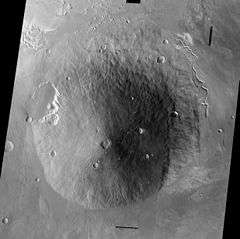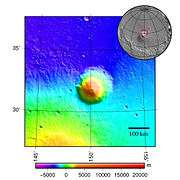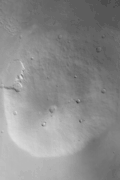Hecates Tholus
Hecates Tholus is a Martian volcano, notable for results from the European Space Agency's Mars Express mission which indicate a major eruption took place 350 million years ago. The eruption created a caldera 10 km in diameter. It has been suggested that glacial deposits later partly filled the caldera and an adjacent depression. Crater counts indicate this happened as recently as 5 to 20 million years ago. However climate models show that ice is not stable at Hecates Tholus today, pointing to climate change since the glaciers were active. It has been shown that the age of the glaciers correspond to a period of increased obliquity of Mars' rotational axis.[1]
 2001 Mars Odyssey THEMIS daytime infrared image mosaic | |
| Coordinates | 32.12°N 150.24°E |
|---|---|
| Eponym | Hecate |
The volcano is at location 32.12°N 150.24°E, in the volcanic province Elysium, and has a diameter of 182 km. It is the northernmost of the Elysium volcanoes; the others are Elysium Mons and Albor Tholus. Hecates Tholus is in the Cebrenia quadrangle.
Origin of name
In planetary nomenclature, a "tholus" is a "small domical mountain or hill". Hecates is named after Hecate, the goddess of the ghost-world, nightly events, and sorcery.[2]
Gallery
 Hecates Tholus topography.
Hecates Tholus topography.
See also
- Climate of Mars
- Geography of Mars
- Geology of Mars
- HiRISE
- List of mountains on Mars by height
- Volcanoes on Mars
- Volcanology of Mars
References
- Huber, Ernst; et al. (17 March 2005). "Discovery of a flank caldera and very young glacial activity at Hecates Tholus". Nature. 434 (7031): 356–361. Bibcode:2005Natur.434..356H. doi:10.1038/nature03423. PMID 15772654.
- Blunck, J. 1982. Mars and its Satellites. Exposition Press. Smithtown, N.Y.
- Mougins-Mark, P., L. Wilson. 2016. Possible sub-glacial eruptions in the Galaxias Quadrangle, Mars. 267, 68-85.
External links
- Google Mars - zoomable map centered on Hecates Tholus
- "Hecates Tholus". Gazetteer of Planetary Nomenclature. USGS Astrogeology Research Program.
- 3-D view of Hecates Tholus from Mars Express
| Wikimedia Commons has media related to Hecates Tholus. |